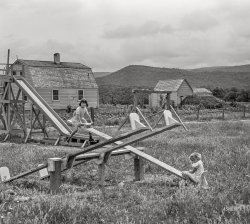
MAY CONTAIN NUTS

Search Shorpy
SHORPY ART

Framed or unframed, desk size to sofa size, printed by us in Arizona and Alabama since 2007. Explore now.
Join and Share
Ad-Free Shorpy
Shorpy is funded by you. Patreon contributors get an ad-free experience.
Learn more.

Recent comments
- Illuminate us
- I remember it well
- I can't prove it
- Complicated then, forgotten now
- Bryan-Stevenson
- Skinny is as skinny does
- How do you rest in peace
- Riding the footboards
- Alas, hidden from view
- Baldwin Diesels
- Exclusive pump
- Bananas, Oysters and Smokey Joe
- Details, Details
- What's that building to the left of the tower?
- Coal Barges
- Bromo-Seltzer
- Inner harbor
- The Basin
- What a headache!
- Giant stepladder?
- Yeah, it was cold
- Love those coats
- Link & Pin Days Remnant
- Baldwin 62303
- Baldwin VO-1000
- Cold
- No expense spared
- Tough Guys
- What's your hurry, where's your hat?
- Sheriff's Signature
Member Photos
The Shorpy
Print Emporium
Print Emporium
Search Shorpy
Search results -- 30 results per page
- Pressure Cookers: 1941
- ... Mille Lacs County, Minnesota." Medium format negative by John Vachon. View full size.
Re: BethF Thank you very much for your kind ... Posted by Dave - 02/28/2020 - 4:42pm -
![Pressure Cookers: 1941 July 1941. "Wife of FSA borrower discussing pressure cooker with home supervisor. Mille Lacs County, Minnesota." Medium format negative by John Vachon. View full size.
Re: BethFThank you very much for your kind words, jd taylor. You made me blush. I firmly believe everyone should eat like they're 8 years old again every once in a while. There's nothing wrong with it. Adult life can be very stressful for any number of reasons, so taking a few moments to be a kid again can reset your equilibrium. At least, it works that way for me.
BethFThat’s one of the best Shorpy comments ever. And this is one of the best lines: “I eat like I'm 8 years old again.”
Grace under pressureYour face is a study in terror, Grace Swenson, and can't say as I blame ya. If I had a 'splodey old pressure cooker like that in MY kitchen, I'd be sayin' novenas!
Well, I'd best be on my way. The day is young, and I have a lot more supervisin' to do. Thanks for the tequila shots!
The NationalJudging from the general shape, the lugs, and the dial, I believe we're looking at a National C21 pressure canner ("21" indicated the capacity in quarts). Smaller-capacity National models used a twist-lock top.
When will it blow?Fabulous photo with its foreboding shadows on the brown paper walls. They both wait for the explosion of the pressure cooker. Who got the timing correct? Mother or daughter?
[That's not her daughter! - Dave]
Mille LacsOnly a thousand lakes? The licence plate has 10,000. And not to be outdone, my home province, Manitoba, just to the north, when I was a kid, decided to go with ten times as many lakes.
All those knobsWon't do a bit of good!
Memories from my childhood.My grandmother had a pressure cooker that looked very similar to this one, and without fail, whenever we went to visit her, she'd cook fresh green beans (picked from the garden that day) and lots of bacon in it. It was amazing. I used to only be able to eat green beans like that, so it was a good thing my mother had one too, albeit a newer model. I've since learned to enjoy green beans in a myriad of different ways, but for good old nostalgia's sake, I make them the way my grandma did, and I eat like I'm 8 years old again.
Pay attention!The borrower seems to know something of canning with all that's alongside the cooking vessel. But, I hope she paid more attention to the pressure gauge than she paid to changing her calendar page.
We still have, and use, a pressure cooker that my mom had from the late forties or early fifties. No trouble yet. Knock on wood.
(The Gallery, John Vachon, Kitchens etc.)](https://www.shorpy.com/files/images/SHORPY-8c19860a.thumbnail.jpg)
- Souvenirs: 1941
- ... Hibbing, Minnesota." Medium format acetate negative by John Vachon. View full size.
(The Gallery, John Vachon, Kids, Mining, ... Posted by Dave - 03/23/2020 - 12:24pm -
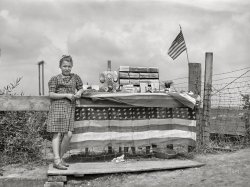
- Mechanical Treatments: 1938
- ... house. Omaha, Nebraska." Medium format negative by John Vachon for the Resettlement Administration. View full size.
Creepy and ... Posted by Dave - 08/02/2017 - 9:22am -
![Mechanical Treatments: 1938 November 1938. "Apartment house. Omaha, Nebraska." Medium format negative by John Vachon for the Resettlement Administration. View full size.
Creepy and it's SpookyThe Addams Family theme song keeps running through my head.
Window Box TreatmentROMINGER, Henry C., of Omaha, NE, died at the age of 95 on November 10, 1951.
The 1940 phone book lists H.C. Rominger at 2308 Douglas, Omaha, NE. (A residential listing. ATlantic 3060, if you wanted to call him).
The house number above the stairs near the Rominger signs in the Shorpy photo is 2312.
The address to the right in the photo appears to be 2310. That would make 2308 the building all the way to the right in the photo, with the lady coming down the stairs. Perhaps 2312 was a corner location with better visibility for signs than 2308. (Google Maps shows this area of Douglas Street to be commercial buildings and parking nowadays, so the street layout probably changed).
Could that be Ms. Rominger coming down the stairs of 2308? Could it be a client, if "mechanical adjustments" meant chiropractic treatment?
He movedThe 1936 Omaha City Directory lists Henry C. Rominger at 2312 Douglas. In 1939 he is at 2308.
If we could enhance the sign on the porch railing beside the steps we might have a better idea of what the mechanical treatments consisted of?
["Physical and mechanical treatments." Terminology was commonly used by osteopaths at the time. -tterrace]
Ham Radio Operator?I wonder if a ham radio operator lives there. That looks like an inverted-V antenna on the roof, which is a common antenna used by hams.
A tangled web of wiresAt one time, it seems someone had a radio to tune in the world or the local stations anyway. I believe Mr. Mechanical Maintenance should throw a little maintenance time to that aerial.
(The Gallery, John Vachon, Omaha)](https://www.shorpy.com/files/images/SHORPY-8b14279a.thumbnail.jpg)
- Gamble's Clipper: 1940
- ... 1940, somewhere in the Midwest. An uncaptioned shot by John Vachon with neighboring 35mm frames taken in Fargo, North Dakota, and Little ... Posted by Dave - 11/21/2011 - 1:52am -
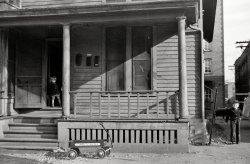
- Ocean View: 1941
- ... Ocean View, outskirts of Norfolk, Virginia." Photo by John Vachon for the Farm Security Administration. View full size.
(The ... Posted by Dave - 12/14/2019 - 2:07pm -
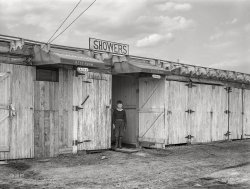
- Lap Time: 1941
- ... County, Minnesota." Medium format acetate negative by John Vachon. View full size.
The primrose path Once more Shorpy has led ... Posted by Dave - 02/29/2020 - 2:43pm -
![Lap Time: 1941 August 1941. "Olaf Ryskedahle and family, tenant purchase borrowers. Freeborn County, Minnesota." Medium format acetate negative by John Vachon. View full size.
The primrose pathOnce more Shorpy has led this innocent down ...
"The Eyes of The world" by Harold Bell Wright was the only title I could make out. Having found the book and author, I was led to read the Wright's Wikipedia entry and discovered that he was the first American novelist to sell a million copies and the first to make a million writing fiction.
Very popular with the public, but as often the case of popular writers, Wright had some detractors in his time.
Owen Wister (author of "The Virginian") laid it on thick. “I doubt if the present hour furnishes any happier symbols [of the quack novel] than we have in Mr. Wright [and The Eyes of the World]. It gathers into its four hundred and sixty pages all the elements ... of the quack-novel. It is,” Wister says, “stale, distorted, a sham, a puddle of words,” and “a mess of mildewed pap.”
It was also number one on the Publishers Weekly bestseller list for 1914.
Once again, Shorpy has seduced me into a pleasant afternoon romp thru Americana. Wright's "Shepherd of The Hills" was made into a movie starring John Wayne while Wister's "The Virginian," with Joel McCrea, are two of my all time favorites.
Thank you.
And one last rabbit to chase. Is our Mr. Ryskedahle a distant cousin Rudolf Rassendyll (Prisoner of Zenda)?
A Ryskedahle ReaderTitles include "The Fighting Edge," "The Eyes of the World," "The Country Beyond" and "Storm Country Polly."
(The Gallery, John Vachon, Kids)](https://www.shorpy.com/files/images/SHORPY-8c19771a.thumbnail.jpg)
- Outdoor Plumbing: 1941
- ... Saginaw Farms, Michigan, an FSA project." Photo by John Vachon for the Farm Security Administration. View full size.
(The ... Posted by Dave - 03/05/2020 - 7:40pm -
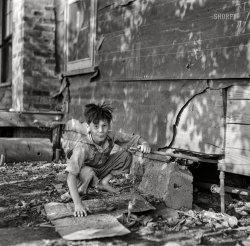
- Farm Noir: 1938
- ... Georgia. View full size. 35mm nitrate negative by John Vachon for the FSA.
(The Gallery, John Vachon, Rural America) ... Posted by Dave - 01/20/2008 - 11:43pm -
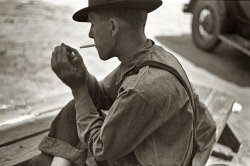
- Expert Advice: 1939
- ... talking to druggist." Medium format acetate negative by John Vachon for the Farm Security Administration. View full size.
Yes ... Posted by Dave - 02/17/2020 - 1:11pm -
![Expert Advice: 1939 September 1939. Graceville, Minnesota. "High school boy talking to druggist." Medium format acetate negative by John Vachon for the Farm Security Administration. View full size.
Yes Harold,we really do need 50 types of toothpaste AND powder.
Coty AirspunThe round orange box with the powder-puff motif hasn't changed since Airspun was introduced nearly a century ago. The loose powder (excellent product) smells like L'Origan, one of Coty's signature fragrances. Coty was about classic femininity then and still is today.
Tooth powderYou don't see that used much anymore; toothpaste has pretty much displaced it.
Guess the ProductI'd say it's Colgate tooth powder.
MayberryFloyd the Barber sells acne cream.
Re: Guess the ProductI think you're right; looking at the enlarged photo, just below the druggist's elbow, there are some containers that resemble the one he's holding. I believe they say Colgate Tooth Powder.
But -- are you sure?It'll work on jock itch? Last time you sold me tooth powder.
Wrong CaptionI love your site, and I love your captions, but surely this one should be captioned "Genius Bar".
[Perhaps a brief review is in order! - Dave]
5 & 10I understand why retailers use prices like $1.99 – it makes the price seem more dollar-y than two-dollar-y. So if a merchant, like this druggist, calls a spade a spade, and has most prices rounded out to 5 or 10 cents, then why would he still have the occasional price ending in 9 or even 8? I get using one system or another, but I don’t get the combination of the two.
Brings back memories!When we were young our mother would not buy toothpaste. We had tooth powder instead. Apparently, we loved to squeeze the toothpaste tube to the point that our consumption of toothpaste went ballistic. Our mother, who had experienced harsh times during the "dirty thirties," moved to stop this waste.
We had to sprinkle a little of the powder in the palm of one hand and dab a wet toothbrush into it. Eventually, as we got older, toothpaste was reintroduced in our home. Oh, happy day!
Floyd? Is that you?I say it is Floyd the Barber.
Love the Coty boxes!At the time this picture was taken, my mother was in her mid-teens; she's now in her 90s. And for as long as I can remember, she's always had one of those very same boxes close by! Loved looking at all the other stuff in this picture, but those really made me smile!
(BTW: my first thought on seeing this picture was of a movie scene with a 1940s kid in a drugstore: "um, I'd like some toothpaste, and gum, and a bottle of Listerine, oh, and a pack of Trojans, and some shampoo, and ... ")
In-band signalingTo davidk's question: I have seen some retailers use the last digit or two of the price to indicate the status of the item in question. For example, if the price ends in 99 cents, that's the regular price. 98 cents is a sale price, and 97 cents is a one-time special buy or a discontinued item. This was probably more common when you didn't have a computer to keep track of the current selling price for you, or label printers that could print new labels quickly for the beginning and end of a sale.
In this case, perhaps the 9-cent or 8-cent prices are items that are in an ad, maybe in the front windows of the drugstore, or in the newspaper. When the sale is over, it's easy to look at the shelf and quickly see which prices need to be changed back to a 5-cent or 10-cent price.
(The Gallery, John Vachon, Stores & Markets)](https://www.shorpy.com/files/images/SHORPY-8c16919a.thumbnail.jpg)
- The Colored Fountain: 1938
- ... Carolina. View full size. 35mm nitrate negative by John Vachon for the FSA.
Halifax This has disappeared into history for most ... Posted by Dave - 09/09/2011 - 2:59pm -
![The Colored Fountain: 1938 April 1938. "Drinking fountain on the county courthouse lawn." Halifax, North Carolina. View full size. 35mm nitrate negative by John Vachon for the FSA.
HalifaxThis has disappeared into history for most people, but I remember it quite vividly. We still had two water fountains and four toilets in North Carolina in the late 1950s.
Strange FruitThis image brought to mind the powerful lyrics of Strange Fruit, sung by Billie Holiday:
Southern trees bear strange fruit,
Blood on the leaves and blood at the root,
Black bodies swinging in the southern breeze,
Strange fruit hanging from the poplar trees.
Pastoral scene of the gallant south,
The bulging eyes and the twisted mouth,
Scent of magnolias, sweet and fresh,
Then the sudden smell of burning flesh.
Here is fruit for the crows to pluck,
For the rain to gather, for the wind to suck,
For the sun to rot, for the trees to drop,
Here is a strange and bitter crop.
Separate but equal?I wonder if there is a near identical drinking fountain on the opposite side of the lawn for whites. This fountain is well made and mounted on a cement base. Was this the former white fountain which has now been downgraded after the installation of a new cooled water fountain indoors?
[If it is, it wouldn't be very equal. - Dave]
RarelySeparate but equal was rarely equal.
Did you know you are a jerk Dave?Dave;
It is a good thing that we as Americans have moved away from the horse and buggy mindset of idiots like you
[Ms. Palin, perhaps you're a bit confused about who is posting what. Either that, or this is a dig at Sarah Palin? I think I get it. - Dave]
I rememberIn 1963 I went on a trip thru the Deep South with a neighborhood family to help watch the children I was 14 years old and had grown up in a segregrated small town in Ohio. I took my little Brownie camera with me. For the first time I saw scenes like this as we traveled. I came home a change person. I grew up alot that summer, when school began that fall I remember taking a stand in my history class for civil rights. I was no long the little girl from a small town in Ohio, I had witnessed the unequality of the Deep South. I was no longer a child.
(The Gallery, John Vachon, Kids, Small Towns)](https://www.shorpy.com/files/images/8a03228u.thumbnail.jpg)
- A Friendly Visit: 1941
- ... Indiana." View full size. 35mm nitrate negative by John Vachon for the Farm Security Administration.
(The Gallery, John Vachon, Small Towns) ... Posted by Dave - 04/13/2008 - 6:01pm -
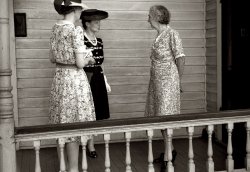
- Camels: 1943
- Another Times Square photo from 1943 by John Vachon, colorized. I hope you all enjoy this one as much as I did. Note the ... Posted by Avzam - 10/16/2011 - 9:59pm -
![Camels: 1943 Another Times Square photo from 1943 by John Vachon, colorized. I hope you all enjoy this one as much as I did. Note the lights left on on the second floor. These are the small things that bring a photo to life. View full size.
Manhattan Fruit Drinks & SkirtsWhat first caught my eye was the corner store in Times Square offering "Papaya" drinks--this in 1943. As a child in Manhattan in the 1950s I remember visiting fruit drink stands with my father--he enjoyed them. Later, I thought the ubiquitous fruit drink stands were a dividend of the Puerto Rican invasion of Manhattan. But maybe NYC was always in favor of fruit juice.
Also, note how abruptly skirt lengths came up as a patriotic gesture!
Like YesterdayYup, I remember this as if it were yesterday. What a great job!!!!!!
Mixed messagesThere appear to be at least three neon slogans in the place where "costlier tobaccos" is painted. Can anyone read the other two?
[The answers to this and other questions appear in the comments under the original B&W photo. - Dave]
The Most Dangerous GameThat billboard reminds me of a Vietnam-era Air Force saying: "An optimist is a fighter pilot who smokes three packs a day and worries about getting lung cancer."
No Yellow Here!I love those old NYC traffic signals with only 2 colors. Who needs amber?
The Color Of Woolworth'sWouldn't the background color of the F.W. Woolworth sign on the left be red with the gold lettering? Woolworth's sign were always red when I saw them in the 50's and later.
A whole lotta light bulbsI wonder how many man-hours it took to screw in all those light bulbs on the Camel sign?
Another fanAvzam, your NYC Vachon colorizations are uncannily realistic. Bravo.
I'd walk a mileI just wish I could grab a pack of Camels, walk to the Cafeteria and listen to some Glenn Miller records. Please keep these WWII NYC photos coming, they are great!
No stockingsThis colorized picture is really amazing. It grips you by the collar and shoots you back in 1943. A gem.
Those two dames, both looking for something in their handbags, are quite funny. After a few minutes of looking at the details of this picture, I came to realize they were not wearing any stockings. Quite normal for 1943, but something you rarely see nowadays.
Bobby SoxersI hadn't thought of that term in a long time; this beautifully colored and evocative wartime picture sure jogged memories.
Cushman CollectionThis photo got me searching for color photos of New York in the 1940s. Found these great photographs taken from the Charles Cushman Collection. Thought some here might also like to see them.
Predecessor to Gray's PapayaElpine Drinks.
Wow, what are the odds?That Bette Davis just happened to be crossing the street just at that moment!
Excellent!This is just beautiful! Fantastic work!
SearchWe see Nancy Walker in the foreground looking for change for the next leg of her journey. I wonder if Chin's is open yet? Another extraordinary job, Avzam! Beautiful. You feel like you're looking through a window into the past. Wonderful
Smoke RingsThose cigarette smoking signs blew smoke rings. I recall one in Milwaukee in the 40s when I was a kid--Chesterfield brand as I recall. The sign was on Wisconsin Avenue at about 2nd or 3rd--on the northwest side of the corner facing southeast. Smoke rings wafted out of the oval mouth out over the street. Caught my eye--after all my Dad smoked as did my Mom at times. I could be and was detailed to buy my parents cigarettes at the tiny neighborhood grocery near my house--Albrecht's. During the War I needed the money and a small stamp from a ration book to purchase smokes. No silly age rules! I didn't take up the habit until I was in college--and have long ago stopped.
WonderfulAnother exquisite job. Please keep them coming!
Still there in 1959.In 1959 my dad sent my mother and me to New York City for a vacation. I remember this sign. As a curious 12 year old boy, I snuck out of my room to check out Times Square, at 4 a.m. It was overwhelming, of course. We also saw "My Fair Lady" on Broadway. And "How to Succeed in Business Without Really Trying" -- Charles Nelson Reilly was in that one. The tickets were around $6. Wonderful memories!
Of COURSE they're not wearing stockings!Hosiery was rationed during WWII. IF you could get stockings, you hoarded them and wore them to a dance at the USO or to see your sweetheart off to the front.
The lady in the fur coat (and stockings!) is obviously well off compared to the girls searching their purses. One can almost see her glance at the young ladies and her sniff of disdain at their fashion sense.
Yellow busesAs an old Manhattanite, the yellow coloration of those busses in the picture hits me in the eye. Actually, the upper portion was closer to buff. I am attaching a photo of a Corgi model which got the colors right.
I love reliving my childhood with these photos Shorpy makes available, and enjoy the many other excellent photos.
Smoke or mirrors? It was years before my Father disabused me of the belief that the 'Smoking Man' on Broadway was puffing real smoke and not steam. It was still a thrilling sight.
(Colorized Photos)](https://www.shorpy.com/files/images/1943_time_sqere_smoke.thumbnail.jpg)
- We Love a Parade: 1939
- ... Carriers Convention Parade." 35mm nitrate negative by John Vachon. View full size.
Now we just cuss at them My mom taught me to ... Posted by Dave - 09/08/2011 - 5:11pm -
![We Love a Parade: 1939 September 1939. Milwaukee, Wisconsin. "Boys watching Letter Carriers Convention Parade." 35mm nitrate negative by John Vachon. View full size.
Now we just cuss at themMy mom taught me to darn socks in the sixties, and I was pretty proud of that thrifty skill. We didn't have the classic darning egg, but used a light bulb as a base. I still use the same technique for mending small holes in sheets and the like. As for socks, now when I see a hole in one, I say, "Darn sock!" and throw it away.
Parade for the poor kids?People think they have it tough now. Look at the clothes these boys are wearing.
It's Dennis The Menace!At first glance I thought the long belt dipping into the back pocket of the boy on the right was a slingshot. Hmmmm, blond hair, cowlick, striped shirt, slingshot in pocket -- it's Dennis the Menace!
That is one raggedy pair of pants on the boy in the middle. He's in his stocking feet, too. Was it poverty? Did his mom just give up on trying to keep his clothes intact? Did he just march (shoeless) to the beat of his own drum?
Innocence Lost.Same time in Berlin thousands were watching troops goose stepping down the Unter den Linden, while the best we could do was muster a ragtag group of letter carriers marching down Main Street.
The boy in the middleMy impression of this boy was that his pants was an older brother's that mom recycled as play pants for him, as to keep his regular pants good and unripped.
I can relateMy father worked for the railroad (1950s). We were poor. Back then you lived in the shacks they provided and made do with the little you had. All of my clothes were handed down from my older brother or donations. I was very small and thin for my age. I had to fold over the waistband on my pants a large amount and my belt went almost twice around my waist. Although not as torn, my pants were heavily mended. Shoes, when I had them, were wrapped in tape to hold them together. Shirts were an option. Dressed as I was, no one ever looked down on me. We may have been poor, but through the eye of a little boy, I never felt so.
Contemporary Font StyleAmazing how font styles, as on the sign in the distance, change over time. That font style was fairly contemporary for the 1930s, and wouldn't have looked out of place in the 1960s-70s. It isn't a font style you would likely to see in the first decade of the 20th century.
As for those slit pants, put that photo in a current ad campaign (distressed/photoshopped to make it look current & hip, of course), and slit pants would be the new "cool."
Holey terrorThe mom of the center kid could just be resigned to the fact that he's a "holey" terror, whose clothes would quickly wind up in shreds no matter what. Plus it's still the Depression, and you had to wrench the last bit of usability out of everything. And it's probably Saturday, and who know what Junior would be getting up to with his goony friends all day long; why let him ruin good clothes? Speaking of getting the most out of stuff, remember Mom darning socks? Do people still do that much these days?
Be Careful ShorpyShowing the well-worn garments of these boys will start yet another new trend in fashion of "extreme shabbiness" taken to the nth degree. Whatever the reason, these clothes were what they had to wear. Today when I see celebs who make $20 million per movie or record deal, I am often fascinated by their carefully ripped, stretched, shrunken, patched and stained clothing. And what is it with the knitted, woolen hats that so many "stars" think makes them look cool? In their case, they CHOOSE to look like ragpickers although I'm thinking these kids did not have a choice. Still, a parade DID present some entertainment and create happiness for lots of people. I used to like them until I hit fifty or so and then realized how ridiculous it was to watch people march in formation to music. Maybe its just cranky old me. And you rotten kids stay off my lawn.
I had a brotherI grew up in the sixties, and my older brother always looked like this. We weren't poor. My mom was a tad thrifty, and play clothes were nothing to be fussy about. He was grubby, torn jeans, barefoot often - it was because he played very hard. You can tell by their tidy haircuts and clean hair that they're well cared for.
Slit jeansWhen I was a kid, this was usually the sign of somebody who had been in a cast after breaking their leg. Mom would slit a pair of jeans so you could slide the cast through.
On the other footSlit-pants seems to have a shoe on his left foot.
[Actually, the kid is bilaterally shoeless. - Dave]
Rough cutSomething that stands out to me about this photo is, the boy's pants are ragged, but, he's clean and his shirt is neatly ironed. As my grandma used to say, "it's no sin to be poor, but it is a sin to be dirty. You can always get a bar of soap."
(The Gallery, John Vachon, Kids, Milwaukee)](https://www.shorpy.com/files/images/8a04324a.thumbnail.jpg)
- Parcel Post: 1941
- ... Siren, Wisconsin." Medium format acetate negative by John Vachon for the Farm Security Administration. View full size.
Siren ... Posted by Dave - 02/27/2020 - 9:54pm -
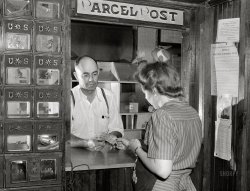
- Albany Mine: 1941
- ... this mine is brought up by truck." Acetate negative by John Vachon for the Farm Security Administration. View full size.
(The ... Posted by Dave - 02/25/2020 - 3:28pm -
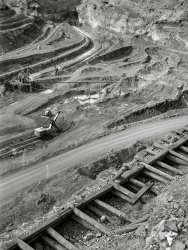
- The Auscultation: 1939
- ... Health Association." Medium format acetate negative by John Vachon for the Resettlement Administration. View full size.
(The ... Posted by Dave - 10/15/2019 - 12:48pm -
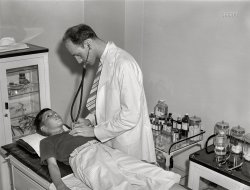
- Boats-n-Buggies: 1940
- ... the A.A. Cooper Wagon & Buggy Co. Acetate negative by John Vachon. View full size.
Logo placement FTW Welcome aboard the bonny ... Posted by Dave - 11/23/2019 - 5:11pm -
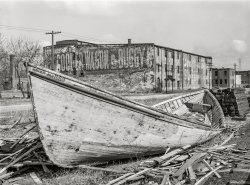
- Superior Scales: 1941
- ... Superior, Wisconsin." Medium format acetate negative by John Vachon for the Farm Security Administration. View full size.
(The ... Posted by Dave - 03/11/2020 - 3:12pm -
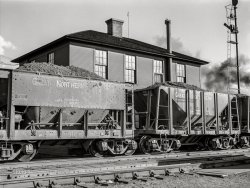
- Big Four: 1940
- ... Illinois -- Big Four Cafe." 35mm nitrate negative by John Vachon for the Farm Security Administration. View full size.
Big Four ... Posted by Dave - 05/25/2012 - 7:58am -
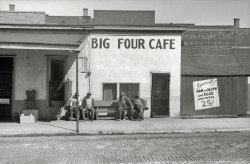
- Keg Run: 1943
- ... turn right at the Sandwich Shanty. Another truck shot by John Vachon. View full size.
Labor Stage, or Princess Theater The caption ... Posted by Dave - 03/08/2013 - 1:31pm -
![Keg Run: 1943 March 1943. "Beer truck on 44th 39th Street and Sixth Avenue." Just turn right at the Sandwich Shanty. Another truck shot by John Vachon. View full size.
Labor Stage, or Princess TheaterThe caption says 44th St, but the street sign on the left says 39th, home of the Labor Stage.
[Caption amended, 70 years after the fact. Better late than never! - Dave]
Roll out the barrelHaving spent my first 22 years in the northeast and being a Polish child in the 1940s & 50's, Sundays were the day that we were forced to listen to polkas on the radio from after church in the morning until about 2 or 3 in the afternoon, (and yes, we did have roast chicken most Sundays-I can even smell it now). I remember particularly the Victor and Sophie Zambroski show in Ct. that went on for hours and they must have played every polka ever written although they all sounded alike to me. Anyhoo, the exposure made us use our imagination (as radio people did) as they all had lyrics in English and so in our minds it was like our own individual mental "hit parade" envisioning how each song would be acted out. The beer barrel polka reminded me of a massive Polish party with the men rolling out ongoing parades of beer kegs, ladies dancing polkas together (since the men did not) and kids just having a riotous good time being crazy and eating themselves to regurgitation. In this picture, with the loosely-packed beer barrels, if those top rows started rolling off, the people getting hit with them would not find it at all enjoyable as I had imagined. Therefore this picture, once and for all, tells me I should re-imagine my childhood fantasies since rolling out barrels may have serious consequences. Sorry to ramble so much, it is a slow day.
Traffic JamThen and now. A few of the original buildings have survived.
Traffic patternsUnlike the time of the photo, W 39th Street is now only a left turn from 6th Ave which hasn't carried 2-way traffic in decades. The site of the two shorter buildings is now a Residence Inn. The next 2 buildings down 39th are still there.
That taxilooks like the famous yellow cab that was in many many movies and ended up at the U.S. pavilion in Montreal at EXPO 67. Movie buffs will have seen that cab in many movies from the 1940's to the 1950's, where is it now?
Trommer'sA little bit of history:
http://www.rustycans.com/COM/month0405.html
Wartime CounterespionageThe caption could have been intentionally misidentified to help protect the nation's wartime supply of Trommer's Beer & Ale.
Trommers of BrooklynTrommers Brewery was just outside the gates of Evergreen Cemetery in Brooklyn. (They had a second brewery in Orange NJ)
Famous for their all malt beer, (no corn sugar used in the conditioning.) They would be the vicitms of the brewery strike of 1949, when their chemists were locked out of the brewery and their yeast strain died. It was said to never taste the same again.
Wooden barrels in 1943, steel kegs came in after prohibition, but if they used steel, they were sent to the scrap metal drives for the war effort, although they may not have made the change yet. (Rheingold in Brooklyn was using wood kegs in '43.) There was such a shortage of beer kegs after prohibition that beer was imported from Germany, and the kegs were part of the deal.
There's a new Marriott Hotel on that far corner now.
Not since 1957Like most odd numbered Manhattan streets, 39th is one-way westbound. As far as I know it's always been that way. The beer truck therefore must be heading southbound on Sixth Avenue, which would have become impossible 14 years after the picture's date when Sixth Avenue became one-way northbound.
The building with the mansard roof on the corner of Sixth and 39th is gone now, as is the building next to it with the Labor Stage sign; the Marriott Residence Inn now occupies the site. The building across 39th housing the Sandwich Shanty also is history. Still around, however, are the two buildings on 39th to the right of the Labor Stage building. The first one is 108 W. 39th, built in 1928, while the second, lighter-colored one is part of a much larger building with the address of 1400 Broadway.
Two other vehicles from the good old days . . .Taxicab looks to be a Dodge (or at least a Chrysler product) of early 40's vintage with skylight - likely with leather upholstery as required by the City of New York for ease of clean-up. In front of the taxi appears to be a coal delivery truck, my guess a Mack AC Bulldog with chain drive - that chassis saw service during WWI. I was born that year, and all those vehicles were still in service well into the 1950's.
When Cabs had Legroom!Back when taxis had rear legroom to spare! There are probably even a couple of jump seats in that Chrysler taxicab.
Calling That CabI agree that the taxi is a Chrysler product, specifically a 1941 DeSoto, both per the design of the taillights and the front trim, as well as the fact that DeSotos were THE most popular make for American big-city taxicabs in the 1940s. Their Chrysler, Dodge, and even Plymouth siblings were very similar mechanically and in body style at the time, but DeSoto got the nod from the cab companies the most often. Watch for the preponderance of DeSoto taxis in photos and movies from the 1940's.
Trommer's Evergreen BreweryTrommer's advertisements from 1915, 1913 and 1909.
Oh, the history ..."I remember particularly the Victor and Sophie Zambroski show in Ct. that went on for hours"
Victor Zembruski and his teenaged bride Sophie started "Polka Time" (later renamed the "Polish Eagle Show") on WATR 1320-AM in Waterbury, Connecticut all the way back in 1934. Victor became ill and retired in the late 1960's, but Sophie carried on as sole host. Sophie herself retired, and handed the show over to her and Victor's daughter ... in 2008. That is not a mistake. Sophie hosted the same radio show for SIXTY FOUR years. She died in 2010, aged 92.
The Bronx Is Up And The Battery's DownIt's hard to tell, but I believe the cab is a DeSoto Skyview. Betty Garrett drove one in the movie "On The Town" with Gene Kelly and Frank Sinatra. These taxis had a moonroof that opened allowed the passengers to see the NYC skyline. They were sold exclusively by the John Water DeSoto Dealership in Long Island City in the Borough of Queens. A story that I heard many years ago that Water was Walter Chrysler's Son-In-Law but could never confirm it.
Coal truckThats a coal truck in front of the Chrysler taxi. I grew up in Great Neck NY and the apartment building in which we lived was heated by a coal fired furnace. The delivery man would put the coal chute through a basement window, then the super had to move the coal to the furnace which was on the other side of the building one wheel barrow at a time. I look back at that and realize he must have spent most of his time feeding that furnace, and that must be why he smelled like coal!
Thank you PeterMy heartfelt appreciation goes out to commenter Peter who added to "the rest of the story" with his update on the Zembruski family in Ct. I never dreamed they were still on the air there and that Sophie worked on the radio until 2008, when she was 90. It is so good to know that a familiar childhood radio show and family name are still playing that happy music as they did 69 years ago. That is quite a remarkable eye-opener and I had no idea it still exists, even now, when almost everything else about my childhood has become extinct, obsolete and long-gone. Thanks again Peter.
Re: DeSotoI am glad to defer to the posters who identified the taxi as a DeSoto, and also thanx to Mr Mel for indentifying the dealership that sold them. As for the coal delivery truck, our house in East New York in Brooklyn took coal directly to a coal bin within shoveling distance of the furnace - this continued until the conversion to oil late 40's/early 50's. This is a great site, especially for the camaraderie among the posters, and Dave and tterrace, as well!
Trucks & CabsThe Trommer's truck is a 1936 or early series 1937 Federal. There appears to be a lantern or some other object between the left front fender and the side of the hood. It looks like the truck body has an access hatch to the bed so (un)loading could take place or a ramp could be attached. If this door is used for unloading, it could be a pretty dangerous way to remove kegs that could roll easily.
The truck number by the door looks like number 346, but the back of the truck shows this is be truck 187.
The cab is a 1941 DeSoto SkyView, probably a model S-8, modified by Mr. Waters. Printed on and above the passenger door the words "DeSoto SkyView." It looks like there is a NY city cab/hack medallion attached in front of the front passenger side door.
Unfortunately Mr. Waters drowned in his pool in May 1941. Ironically a short biography of him was featured in the April 7, 1941 issue of Time Magazine.
Here is an excellent article and photos of Waters' automobiles.
+71Below is the same view from September of 2014.
(The Gallery, Cars, Trucks, Buses, John Vachon, NYC)](https://www.shorpy.com/files/images/SHORPY_8d26821a.thumbnail.jpg)
- Ak-Sar-Ben, Ah-a-Mo: 1938
- ... and Nebraska at Omaha. View full size. Photograph by John Vachon.
Neat sign Love the wording on the sign. Can anybody tell us the ... Posted by Dave - 08/02/2017 - 9:24am -
![Ak-Sar-Ben, Ah-a-Mo: 1938 November 1938. The Ak-sar-ben toll bridge over the Missouri River between Iowa and Nebraska at Omaha. View full size. Photograph by John Vachon.
Neat signLove the wording on the sign. Can anybody tell us the origin for the name of the bridge?
[Nebraska spelled backwards. - Dave]
Thanks.....for clearing that up Dave. Dumb ole me, I thought it was some type of Arabic name. Wonder how much the toll was to cross the bridge?
I currently work as a toll collector in AD-IR-OLF but I wouldn't want to put that (name) on a sign, these drivers are usually confused enough.
Huh?"Your Tolls Will Make It Free"
Um...what??
Beyond that, the toll booth seems to be on the wrong side of the road for a Drive-on-the-left country...
Ak-Sar-BenApparently there's more to the story than that. According to Wikipedia it began in the 1890s when a group of local business leaders were trying to keep the Nebraska State Fair in Omaha. One of the things they wanted to try was to bring the Mardi Gras floats from New Orleans to Omaha. While in New Orleans this group was so impressed by the Mardi Gras Krewes that they decided to establish an organization based on that concept in Omaha. When asked to come up with a name one of the members said "Why not reverse the name of our beloved state, since everything seems to be going backwards these days?" Thus was born the Knights of Ak-Sar-Ben.
One of the things that the Knights did was to buy the Douglas Street Bridge (the first road bridge across the Missouri River) and rename it the Ak-Sar-Ben Bridge. As the sign says they hoped to end the practice of charging tolls. The Bridge eventually became a free bridge in 1947. It was replaced by a girder bridge for I-470 in 1966 and demolished in 1968. Among other things the Knights of Ak-Sar-Ben owned an operated a race track and arena complex from 1920-1990, and were minority owners of an AHL hockey team from 2005-2007.
Yo, Nilbog guy!"Your Tolls Will Make It Free"
They told us that story here, too. Maybe they meant your Trolls will make it free. The purported idea is that once the cost of building the road has been recaptured, the public will be granted unfettered access. And if you believe that story...
Maybe it happened somewhere at sometime, but not in Harris County.
Yo, slr in tx guy!Toll roads in Houston/Harris County may be permanent, but things are a bit more civilized in the neighboring Chicken Fried Nation of Dallas-Fort Worth. What is now Interstate 30 between the two downtowns was once called the Dallas-Fort Worth Turnpike. The toll booths disappeared (along with the tolls!) in 1977.
Tom Landry HighwayThat section of I-30 was named after The Man in the Hat in 2001.
(The Gallery, Boats & Bridges, Cars, Trucks, Buses, John Vachon, Omaha)](https://www.shorpy.com/files/images/11763u.thumbnail.jpg)
- No More Books: 1940
- ... County, North Dakota." Medium format acetate negative by John Vachon for the Farm Security Administration. View full size.
(The ... Posted by Dave - 12/15/2019 - 1:04pm -
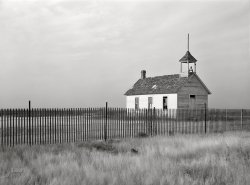
- The Alamo: 1937
- ... D.C. View full size. 35mm nitrate negative by John Vachon for the Farm Security Administration.
For Rent I wonder how much ... Posted by Dave - 09/09/2011 - 10:51am -
![The Alamo: 1937 December 1937. The Alamo movie theater in Washington, D.C. View full size. 35mm nitrate negative by John Vachon for the Farm Security Administration.
For RentI wonder how much that room was for rent.
[That might be office space. - Dave]
The movies"Law of the Ranger" was one of a series of low budget "B" pictures done for Columbia, starring Robert Allen as "Bob Allen." Allen, who was a Dartmouth graduate, basically had his movie career ended with the arrival of singing cowboys like Gene Autry. He basically stopped working in film by 1940 and acted on Broadway. He made his last movie - the totally awful "Raiders of the Living Dead" in 1986 at age 80. He died in 1998 at age 92.
While "The Outer Gate" is an entirely forgettable second feature crime movie with a paper thin plot, the three main actors are an interesting group. Ralph Morgan, who is first billed, was the first president of the Screen Actors Guild, as well as the brother of Frank Morgan, who played the Wizard in "The Wizard of Oz." Ben Alexander, in the lead role, spent much of the 1950s as Joe Friday's partner in the TV series "Dragnet." Kay Linaker, who was the female lead in this movie was born in 1913, and is not only still alive but was at one time the oldest College instructor in New England (at Keene State College in New Hampshire).
"Shadow of Chinatown" was a 15 chapter serial starring Bela Lugosi acting in "yellow face" which was indicative of how far his career had fallen by this time. It also starred Herman Brix, the 1928 Olympic Silver medalist in the Shot Put, who had just finished playing Tarzan in a serial. Brix would later change his name to Bruce Bennett and became a major star at Warner Brothers. He died in February, 2007 at age 100 of "complications from a broken hip."
Re: RentI don't know about the rent, but if you had all those posters today in that condition, you would be able to put a nice down payment on a house.
Parallel ParkingIn the days before power steering, that was real good parallel parking by drivers of cars in front of theater. Spacing even good.
That is, if they didn't pull to curb one after another!
Alamo TheaterThe Alamo was located at 1223 Seventh street N.W.
Remembering the Alamo The Alamo Theater was renamed before it was demolished. Do you know what was the name of the theater that was here when the building was demolished?
Thank you for your attention to this query. REM
StudebakeryWhen I saw this car I felt a little tug because it reminded me so much of my folks' first car, a 1935 Studebaker. Am I correct?
The way we wereThe Alamo became the Mid City Theatre before falling to the wrecking ball.
http://www.cinematour.com/theatres/us/DC/2.html
Research on the Alamo and the Mid City TheatersThis photograph prompted us to do further research on the Alamo Theater by featuring it in our weekly photo quiz on www.forensicgenealogy.info for the week of Nov 16, 2008.
Our readers' outstanding research uncovered contradictory information about the address and history of this theater. While the comment above indicates that the address was 1223 7th St, Washington DC, we also found two other addresses: 1293 7th Ave on www.cinematour.com (with the Mid City located at the 1223 address), and 1223 on 9th Ave on the Shaw District site at www.culturaltourismdc.org (The latter might be a misprint.)
Whichever is correct, the Alamo and The Mid City were two separate theatres, not the same theatre with different names at different times.
I've posted the results of our research on the Alamo at www.forensicgenealogy.info/contest_184_results.html.
Colleen Fitzpatrick
www.forensicgenealogy.info
[1223 Seventh Street would seem to be correct. Washington doesn't have numbered avenues -- there is no Seventh or Ninth avenue. And there is reason to believe there was a Mid-City Theatre at the same address. See the Washington Post clippings below. - Dave]
Dave gives me GoosebumpsOh, how I flush! It causes a shiver up my spine and goosebumps on my flesh to witness how Dave stands up for my honor (or at least the honor of my research). Forensic genealogy is a curious new website to me and I am intrigued by their postings. While the researchers at this website do highlight some contradictory information available on the web, it does appear, as Dave documents, that the Alamo was indeed located at 1223 Seventh street N.W.
Following up on one of the comments from the aforementioned website, the New Yorker magazine featured a brief humorous observation regarding the Alamo in the Talk of the Town section on Oct 17, 1959.
Following up on the address...Following up on Colleen's comment, I looked a little more into the address of the Alamo Theatre. Found this interesting website and picture:
http://www.historydc.org/Do_Research/research.asp?ID=128909&IMAGE_NUMBER...
Descriptive text lists the photo as...
"Commercial buildings on the east side of the 1200 block of 7th Street NW. View to north. Including the Alamo Theatre."
As the Alamo is the second building from the near end (and the numbers ascend to the North), 1203 seems reasonable. It also looks like the MidCity Theatre is visible part way down the block (counting by twos) it would be 1223 7th ...
Another Photo of the Alamo Showing the CornerHi,
Dave's comments appear to be correct. There is a second photo on the historydc.com website that shows the Alamo second from the corner, but with a shorter building on the corner next to it. See http://www.historydc.org/Do_Research/research.asp?ID=128909&IMAGE_NUMBER...
So I think we are converging on the address being 1203 7th St. NW. I believe too that the address given on the www.cinematour.com site (1293) was probably a typo, and was meant as 1203.
I appreciate everyone's help in clearing up this asterisk in cinema history. I've posted a summary of the discussion on my blog at www.forensicgenealogy.info/blog.
Colleen
Alamo ReduxOK, I'm convinced that the early quoted Washington Post article referencing 1223 Seventh was a typo and the true address is 1203.
Building Permits
Charles J. Bedell, owner, to remodel theater, 1203 Seventh street northwest, $200
Washington Post, Jan 18, 1914
Fire Record.
12:22 p.m. - 1203 Seventh Street northwest, film in booth.
Washington Post, Dec 23, 1939
A Listing of Washington Movie Theaters - 1984.
Alamo, 1203 7th St. NW
Washington Post, Nov 15, 1984
Parked CarsNone of these cars is a Studebaker. Although the body style resembles a 1936 (not 1935) Studebaker President, to some degree, the '36 Stude' has only one piece of side trim, does not have chrome headlight buckets, and it has a different radiator mascot.
The car on the left looks like a 1935 - 1936 Dodge, but the gas filler is in a different location than I see in other pictures (on the fender instead of on the trunk).
The car in the center is a 1936 Chevrolet.
The way the car is parked it almost looks like one of the "Outer Gate" movie poster characters behind the car is actually in the back seat.
The car on the right is a 1935 Ford.
(The Gallery, Cars, Trucks, Buses, D.C., John Vachon, Movies)](https://www.shorpy.com/files/images/8a02976u_0.thumbnail.jpg)
- VicPenn: 1943
- ... Note the wings atop the tank. Medium format negative by John Vachon, Office of War Information. View full size.
Mirror? What ... Posted by Dave - 11/04/2013 - 7:46am -
![VicPenn: 1943 March 1943. "New Orleans oil truck." Note the wings atop the tank. Medium format negative by John Vachon, Office of War Information. View full size.
Mirror? What Mirror?Many times I have seen pictures of assorted trucks on Shorpy that sported very small outside mirrors or, more commonly, none at all. Considering the volatile nature of this truck's contents it must have not been a safety consideration during this era to have some kind of mirror on the passenger side.
Safety chainNote the anti-static grounding chain dangling under the rear of the trailer. This was common practice well into the 1950's. When a tank truck passed you could hear the chain jingling as its end dragged and bounced along the road.
Purpose of the smaller cans?Would the driver be using those smaller cans to trade full for empty cans from smaller users?
I'd guess they are five-gallon capacity, and they are probably all painted red, although some are pretty beaten up.
Looks as though the rail holding them in is permanent, so maybe they were a fixture of the relatively young delivery system which was still evolving.
[See these two forum posts. -tterrace]
Wasn't that a punk band?The Inflammables, I mean. I've never seen it used in the plural like that, although when I was a kid in the '60's they seemed to be transitioning from that to "flammable." Nowadays they just run with the Hazmat placard. It reminds me of R.E. Lee's soldiers, calling themselves "Lee's Miserables."
Static ElectricityDragging chains, and spring loaded wires sticking up from the pavement at toll booths, are no longer necessary. Modern-day tires aren't such good electrical insulators as their older versions were. Tires are now built to dissipate static electricity and keep it from building up on the vehicle.
(The Gallery, Cars, Trucks, Buses, John Vachon, New Orleans)](https://www.shorpy.com/files/images/SHORPY_8d28178u.thumbnail.jpg)
- Nebraska Power: 1938
- ... "Nebraska Power Company, Omaha." Medium format negative by John Vachon for the Farm Security Administration. View full size.
(The ... Posted by Dave - 08/02/2017 - 9:23am -
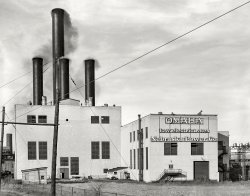
- Life and Times: 1938
- ... "Omaha, Nebraska, newsstand." Medium format negative by John Vachon for the Farm Security Administration. View full size.
Adventure ... Posted by Dave - 08/02/2017 - 9:20am -
![Life and Times: 1938 November 1938. "Omaha, Nebraska, newsstand." Medium format negative by John Vachon for the Farm Security Administration. View full size.
Adventure ComicsI see #32 is on the stand, the first issue under that title. These were published by DC. Superman 6 months earlier on action but his dad Jor-el preceded him by a year in this series #12
Tracked down another one that's still around.Fur-Fish-Game is to the left of The New Yorker.
You DevilThat is a temptation to some talented, artistic individual to colorize it. You devil!
LIFE MAGAZINE - Brenda Diana Duff FrazierShe was an American socialite popular during the Depression era. Her December 1938 debutante ball was so heavily publicized worldwide, she eventually appeared on the cover of LIFE magzine for that reason alone. She was known and dubbed as a "Poor Little Rich Girl" by the media, together with socialites and other famous debutantes Barbara Hutton, Gloria Vanderbilt and Doris Duke. There is a Wikipedia article on her.
Not Asimov's "I, Robot"I spotted the January 1939 issue of Amazing Stories which included "I, Robot." The story bears no relation, other than the shared title, to the Isaac Asimov short story collection from which the movie derives.
[Your linked Wikipedia article states "Asimov was heavily influenced by the Binder short story." -tterrace]
Easy, breezy, beautiful....Cover GirlI'm reading that issue of Life Magazine right now, the one with Brenda Frazier on the cover. My father has a ton of old issues of Life, which he inherited from his mother, and that happened to be the one I grabbed just a couple of hours ago, before I logged in to Shorpy. How fortuitous. Or is it serendipitous?
One thing I cannot make out is who is on the cover of Time. I thought it was J. Edgar Hoover, but 1938 would be too early, I think, for him to be on the cover of any magazines.
[Hoover first appeared on a Time cover on the August 5, 1935 issue. It's Henry Grady Weaver on the November 14, 1938 issue.]
Won't somebody help that poor girl !?!10 Complete Stories of True Gang Life !!!!!
New YorkerThe Nov. 12, 1938 issue. Spanning pages 30 and 31 is an amusing cartoon spread documenting various Emotional Crises, including new mother-in-law, a friend in tears, contagious disease, and demonstrative child.
One of the BestNo one spotted the Billboard cover with Spanish ventriloquist Señor Wences? He’d have been 42 in 1938. He lived to be 103. There are a flood of Wences videos on YouTube. In the photo his characters of Johnny and Pedro hadn’t completely evolved into what they later looked like.
That must have been someone's jokeA copy of "Better English" in the middle of a solid row of pulp magazines!
Short list of survivorsWhich of these are still in print?
I count
Time
The Atlantic
Redbook
Catholic Digest
Consumers Digest
Billboard
Readers Digest
The New Yorker
Maybe others???
Additional survivorI am so lowbrow:
Adventure Comics
Edit: Oops! I was wrong listing this as a survivor. According to Wikipedia, the last Adventure Comic was number 529, cover dated September 2010. Too bad.
QSTThere is another survivor: on the third row near the center, just barely visible is “QST – devoted entirely to amateur radio.”
QST has been published continuously by the American Radio Relay League since 1917.
According to current editor Steve Ford, “QST hasn’t been on newsstands in nearly 20 years, but there was a time when newsstands were one of the most important means of magazine distribution.”
Another Survivor"Astounding Science Fiction" changed its name to "Analog Magazine" back in the '60s and kept right on.
ScreenlandWith Bette Davis and Errol Flynn on the cover. Plus (at last): "The REAL truth about Hollywood Stars' Dieting."
Two moreBreezy Stories:
https://sites.google.com/site/modernthrills/breezystories
Newsstand colorizedAs TheGeezer said, this newsstand screams for a "color"-man. Here you will find the result of quite a few hours work.
I added rownumbers, who can help completing?
The missing ones:
Row 0 Poster: 1939 CARS in Collier's automotive issue
Row 1 Ten Story Sports
Row 1 Better English
Row 6 Automobile and Trailer Travel
Row 7 Every Day Astrology
Row 8 Psychology (How "suggestible" are you?)
Row 8 The American Dancer
Row 8 Pathfinder
Row 8 Home Friend
Row 10 Youth
Row 12 Catholic Digest
Row 13 Mc Call's (Three Magazines in One) december 1938
Row 15 The Billboard (World's Foremost Amusement Weekly)
Row 17 Death in the Deep South - A Mercury Book
Row 17 Poster: Mademoiselle
or wrong issue ones:
Row 7 Star Sports Magazine (1938-07, should be 1938-11)
Row 8 Outdoorsman (1938-09, should be 1938-11 or -12)
Row 8 Outdoors (1938-03, should be 1938-11 or -12)
Row 9 World Astrology (1937-03, should be 1938-11)
Row 10 Your Life (1943-12, should be 1938-12)
Row 10 The Popular Educator (#44, should be #35)
Row 11 Sweetheart Stories (1938-10, should be 1938-12)
Row 16 Your Life (1943-12, should be 1938-12)
Row 16 Book Digest (1950, should be 1938)
And .... the unidentified ones:
Row 1 ..he Sky!! ....tion (Action??)
Row 2 Su.... Co....
Row 2 Curre(nt?) Histo(ry?)
Row 2 Mich...
Row 2 Cartoon …
Row 2 Aero Digest …
Row 2 Ope... Roa..
Row 3 Radio .....
Row 3 W(D/P/R??)...
Row 3 Dogd...
Row 3 Writer's ....
Row 4 (Radio?) & (Televi?)sion
Row 4 ???
Row 4 Flower ....
Row 4 -----
Row 4 ....Y... (.... crossword puzzle on pages 14 & 15)
Row 5a .OT....
Row 5a Ten-.... Lo....
Row 5a R.... (Stories of western avengers in action)
Row 5a Come(dy?)
Row 5a Photogra(pher's?) Han(dbook?)
Row 5a Ac(tion?) Adv(entures?)
Row 5a Personal Confessions?
Row 5b Good Photograph(s/y/er?)
Row 5b Nau(tical?) Mag(azine?)
Row 5b To(p?) Ast(ronomy?)
Row 6 ----
Row 6 ----
Row 6 ....men
Row 6 Automobile …?
Row 7 .....st
Row 8 Inside L.. (The secret love slave and the doomed physician)
Row 8 Air? Progress
Row 8 American .... (Crowd?)
Row 9 ----
Row 9 Daily ...
Another survivorFarm Journal (middle of the 3rd row down in the main case).
(The Gallery, John Vachon, Omaha)](https://www.shorpy.com/files/images/SHORPY-8b14271a.thumbnail.jpg)
- Johnny's Jammies: 1940
- ... April 1940. Click. Another selfie of photographer John Vachon, last seen here , in the mirror of his Dubuque hotel room in bed in ... Posted by Dave - 11/25/2019 - 10:30am -
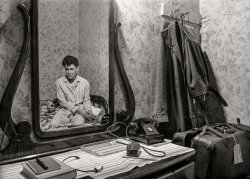
- Full Service: 1940
- ... at service station in Cairo, Illinois." 35mm negative by John Vachon for the Farm Security Administration. View full size.
Premlar ... Posted by Dave - 05/23/2012 - 10:59am -
![Full Service: 1940 May 1940. "Wiping off windshield at service station in Cairo, Illinois." 35mm negative by John Vachon for the Farm Security Administration. View full size.
PremlarAs a high school kid, I worked at a gas station for a couple years. We initially had the bow ties, but no caps. Then that sort of went by the wayside.
We had one regular customer who ALWAYS wanted us to 'fill it up premlar'. I never was sure why. Did he want half a tank each of premium and regular? We just gave him premium and he was happy with that.
KaroCairo is the southernmost town in Illinois. The folks I was working with there explained that I should pronounce the name the same as "Karo" syrup.
Full serviceYou don't get that anymore. I worked the full service island at a Mobil station when I was in high school. Check under the hood for you ma'am? Left rear looks a little low. Ah, the days of sell-ups. I even got to pump Ethyl.
WindshieldI wasn't around in 1940, but I am old enough to remember "full service." It always seemed that the pump jockey was able to clean off my windshield better than I ever could, even to this day. No streaks! Wonder what kind of magic solution they used in that pump spray bottle?
Can I Get 50 cents Worth Please?I'll bet he has the chrome change dispenser on the front of his belt. Those things were murder on paint jobs back then if the guy wasn't careful. Don't ask me how I know.
Memories of Dad and the gas stationThe stop for gas was a ritual that fascinated me. Loved ding-ding as the car drove over a sort of hose. Dad got out of the car, conferred with the attendant, and asked for a fill-up. The windows were cleaned, tires and oil checked, etc. Everything in place, we drove off.
Me tooWorking at a gas station I pumped the gas, cleaned the windshield, checked the tire pressure, opened the hood, checked the oil and fan belt condition/tightness and filled the window washer tank if the auto was so equipped. Changing tires with an old manual bead-breaker was not my favorite job though.
Who's Ethyl?!?!?My kids looked at me like I was crazy (shut UP!) when I said that my FJ Cruiser would only run on Ethyl.
Glad someone else remembers the term!
--Jim
Full Service Gas still exists at no extra costThere are two states where they still pump the gas for you. Residents of Oregon and New Jersey don't have self serve pumps even now. Of course the people who pump the gas don't have sparkling white uniforms with caps, don't do it from globe top dispensers, never have any leaded gas on hand, let alone HiTest or Ethyl, and don't charge 26 cents a gallon any more.
1940 Plymouth?I think the instrument cluster matching what we can see of the posted car gauges is a 1940 Plymouth.
[Wow! -tterrace]
Sinclair Service AttendantGrowing up we had a Sinclair service station near us and I was always intrigued with the dinosaur logo they used. I see they are still in business but I haven't seen a service station in our area for years.
My first real jobAround 1976,I hired on as a mechanic at a local Mobil gas station. I was taught to check under the hood, check the tires, wash the windshield and notify the customer if the oil was low or dirty, and steer them to an empty bay if we had one. The station did not allow self-serve, and this was about the time that self-serve was the majority. We were one of the last full serve stations for many miles. I made a whole $2.10 an hour doing tuneups, carb repair, engine overhauls, transmission overhauls, clutches, and I also used the old manual tire machine. In trade school, they required you to learn how to use the antique, because some of us would be hired at a shop that still used that as their primary tire changer. The reaosn I got the job was because I was fluent with the antique and impressed the boss that I could change a tire faster than he could (a 70 year old man with arthritis)
(The Gallery, Gas Stations, John Vachon)](https://www.shorpy.com/files/images/SHORPY_8a06350a.thumbnail.jpg)
- Where's My Remote: 1938
- ... Which one is ours again? Medium format nitrate negative by John Vachon. View full size.
Thought this was Russia When I first saw ... Posted by Dave - 02/20/2013 - 9:34pm -
![Where's My Remote: 1938 July 1938. "Garages in alley behind row houses. Baltimore, Maryland." Which one is ours again? Medium format nitrate negative by John Vachon. View full size.
Thought this was RussiaWhen I first saw this photo I thought it was set in Russia, where I saw many of these garageplexes in every city I visited back in the Soviet days. When you lived in a Stalin-era apartment highrise, you had to have some place to put your car, not so much for parking, but for working on it, because keeping a car running was a challenge back then.
[Not to mention getting one. - Dave]
X marks the spotX marks the spot.
Marble StepsAround front, one set for each garage door.
Malvina Reynoldswrote "Little Boxes"; Seeger (and others) only sang it. She wrote a whole lot of songs, actually; worth looking up on YouTube.
Overhead is BetterHaving endured such a garage (and such garage doors) during a blustery winter in Ft. Leavenworth, I can state unequivocally that getting your car out on a windy morning requires either three people or one driver and two cinder blocks.
The aroma!Those old fashioned wooden garages had SUCH a delicious aroma! A blend of old motor oil, dry, unpainted wood, and who knows what else. Strong, pungent aroma. And you have to look far and wide to find one like this any more.
VERY narrow rowhouses?If the garages are lined up behind the row houses at one garage per, the residences must be very narrow.
Re: Old Garage AromaWe had a garage similar to this when we lived in Brooklyn in the 50's. I know exactly what Jazznocracy means by the aroma. I often accompanied my Dad on the two block walk to the rented garage to retrieve the '39 DeSoto or the '50 Plymouth when we upgraded. Oddly, one of my better memories of that garage was the "lock protector" that Dad crafted from a piece of an old tire to keep the rain out.
Thanks, 'jwp'Hate to come home on a Saturday night and enter this alley from the wrong end. 'The seventh garage on the right side' could turn into a real adventure!
Eau de 10W40That aroma dear to car nuts may have been due to the habit of draining the oil directly onto the garage's dirt floor, where it soaked in (harmlessly, as was thought back then) and perfumed the air for an eon or two. Most of the hazmat that has to be remediated when military facilities are turned over for civilian purposes, for example, can be chalked up to motor fuels/lubricants' and used dry-cleaning fluids' being disposed of by dumping -- a common practice for decades and cetainly not restricted to the military. In fact, coastal cities in California (and presumably elsewhere) often have stencilled on curbs above storm drains the legend "No dumping/Drain discharges to ocean."
Traffic JamImagine the fun of backing out of one of these garages when several of your neighbors, next to and across from you, were doing the same.
Old garage aroma solved.When I built a new garage several years ago, it had the smell of adhesives and curing cement. Ugh. I found an old garage that was about to be demolished not far from my house with a very heavily built 30 foot workbench. At least 50 years old, with paint stains, oil, and who knows what else on it. After liberating it from it's doomed home, my neighbor and I split in half, and now we each have that great smell without the wait.
ListenA variation on a certain Pete Seeger song comes to mind.
Garage vs. house widthThe garages are probably not directly behind individual houses. I don't know where in the city these particular garages are, but here's another Baltimore example.
I heard through a neighborhood oral history project that back when cars were relatively rare, you weren't allowed to leave them on the street! Had to go in a garage at night. There are some in the alley behind our block, but definitely not one per house (we don't have one).
ooo-ooo that smell!As a realtor, I still occasionally get to experience the aroma of old garages here in Tulsa. And it's not just confined to garages. Old homes have their own unique scents as well. Sometimes, too, an old, vacant home can tell you stories if you just observe. For example, I showed one home close to downtown and behind a bedroom door were these different ruler marks notating a child's height as he progressed through life. The years were jotted down - 1930s to 1940s. Old structures will speak to you if you let them.
(The Gallery, Baltimore, Cars, Trucks, Buses, John Vachon)](https://www.shorpy.com/files/images/SHORPY_8b38447a.thumbnail.jpg)
- Teeter Tots: 1939
- ... West Virginia." Medium format acetate negative by John Vachon for the Resettlement Administration. View full size.
(The ... Posted by Dave - 10/15/2019 - 3:04pm -
